Physical Address
304 North Cardinal St.
Dorchester Center, MA 02124
Gastroesophageal reflux disease (GERD) is the most common benign medical condition of the stomach and esophagus. In patients with GERD who experience persistent life-limiting symptoms despite maximal medical therapy, antireflux surgery should be strongly considered. The application of laparoscopy to antireflux surgery has decreased perioperative morbidity, hospital length of stay, and cost compared with open operations. Conceptually, laparoscopic antireflux surgery (LARS) is straightforward; however, the correct construction of a fundoplication requires significant operative experience and skills in complex laparoscopy. In patients who present with late complications of antireflux surgery, including recurrent GERD and dysphagia, reoperative antireflux surgery can be effectively performed. Compared with first-time operations, however, reoperative antireflux surgery is technically more challenging, is associated with higher risk of perioperative complications, and results in less durable symptom improvement. Consequently, surgeons should have a higher threshold for performing reoperative antireflux surgery, and reoperations should be performed by experienced, high-volume gastroesophageal surgeons. To decrease perioperative risk and to maximize long-term relief of GERD symptoms, surgeons must be familiar with all aspects of preoperative evaluation and operative management of patients with GERD.
Hernias at the esophageal hiatus span the spectrum from a small sliding hiatal hernia to a large paraesophageal hernia (PEH). Similarly, the symptoms of PEH can vary from mild GERD and gastroesophageal obstructive symptoms to severe, acute complications, including gastric volvulus, which requires immediate evaluation by a surgeon. The repair of a large PEH is challenging, but when it is performed at high-volume centers by experienced surgeons, hiatal hernia and PEH can be repaired safely and provide patients with long-lasting control of gastroesophageal symptoms.
Technologic advancements in the surgical management of benign gastroesophageal disease include the application of robotic assisted laparoscopic surgery and the use of magnetic sphincter augmentation devices (MSADs) at the lower esophageal sphincter (LES). These options hold promise for further advancement of the care of patients with these conditions; however, they do not supplant the need for comprehensive understanding of these disease processes, perioperative patient management, and technical expertise in operative correction of these conditions.
Endogenous antireflux mechanisms include the LES and spontaneous esophageal clearance. GERD results from the failure of these endogenous antireflux mechanisms.
The LES has the primary role of preventing reflux of gastric contents into the esophagus. Rather than a distinct anatomic structure, the LES is a zone of high pressure located in the lower end of the esophagus. The LES can be identified with esophageal manometry.
The LES is made up of four anatomic structures:
The intrinsic musculature of the distal esophagus is in a state of tonic contraction. Within 500 milliseconds of the initiation of a swallow, these muscle fibers relax to allow passage of liquid or food into the stomach, and then they return to a state of tonic contraction.
Sling fibers of the gastric cardia are oriented diagonally from the cardia-fundus junction to the lesser curve of the stomach. Located at the same anatomic depth as the circular muscle fibers of the esophagus, the sling fibers contribute significantly to the high-pressure zone of the LES ( Fig. 43.1 ).
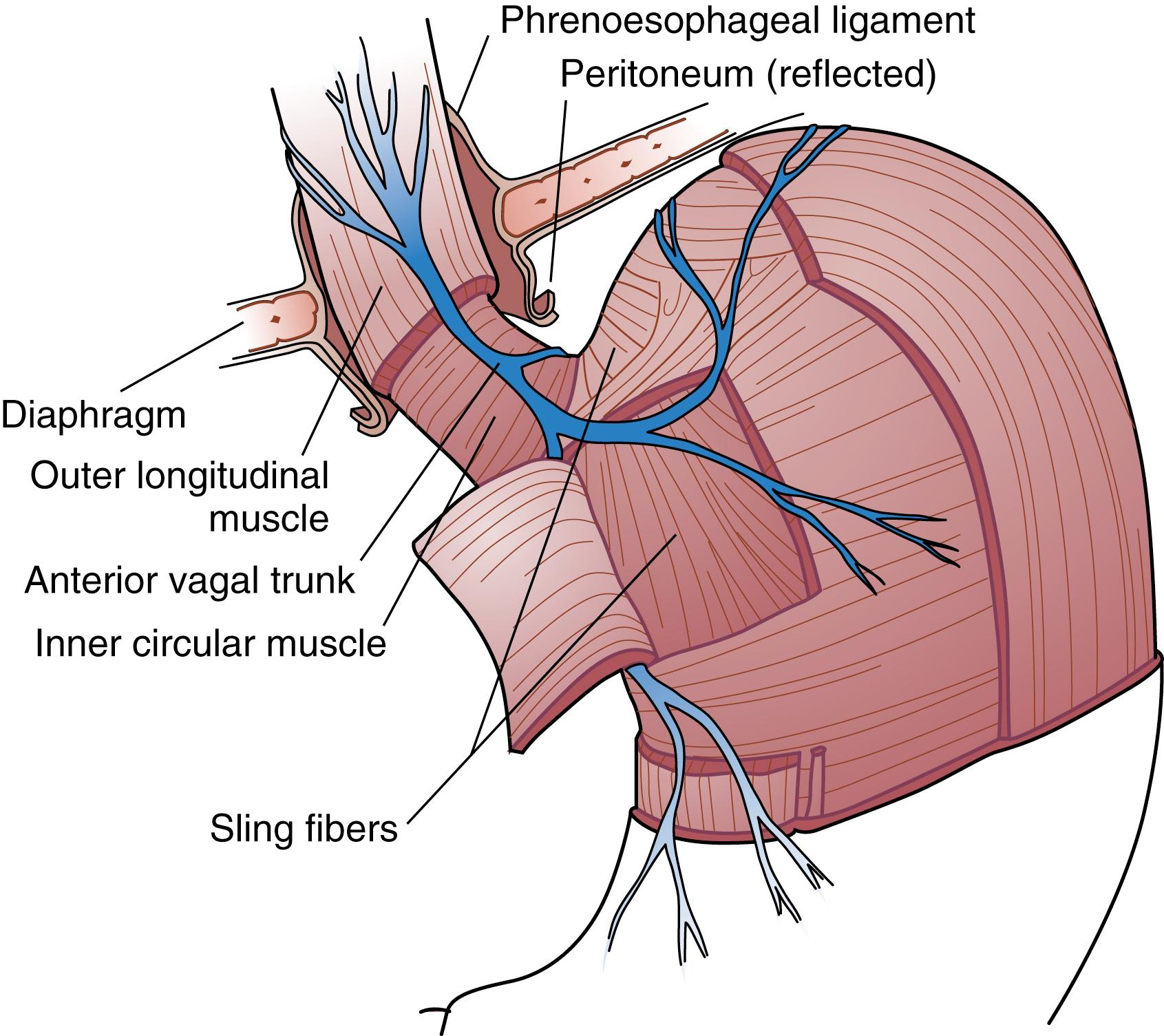
The crura of the diaphragm surround the esophagus as it passes through the esophageal hiatus. During inspiration, intrathoracic pressure decreases relative to intra abdominal pressure, favoring the movement of intra abdominal gastric contents into the esophagus located in the posterior mediastinum of the thorax. To counteract this pressure differential during inspiration, the anteroposterior diameter of the crural opening is decreased, compressing the esophagus and increasing the measured pressure at the LES. Because of this fluctuation in LES pressure, it is important to measure the LES pressure at mid-expiration or end-expiration.
When the gastroesophageal junction (GEJ) is firmly anchored in the abdominal cavity, increased intra abdominal pressure is transmitted to the GEJ, which increases the pressure on the distal esophagus and prevents spontaneous reflux of gastric contents.
Gastroesophageal reflux (GER) occurs when intragastric pressure is greater than the high-pressure zone of the distal esophagus. This can develop under two conditions: the LES resting pressure is too low (i.e., hypotensive LES) and the LES with normal resting pressure inappropriately relaxes in the absence of peristaltic contraction of the esophagus (i.e., spontaneous LES relaxation). Hypotensive LES is frequently associated with hiatal hernia because of displacement of the GEJ into the posterior mediastinum. However, hypotensive LES can occur in its normal anatomic position, and even small changes in this high-pressure zone can compromise its effectiveness.
Not all GER is pathologic—in fact, it is a normal physiologic process that occurs even in the setting of a normal LES. Physiologic GER provides us the ability to rapidly evacuate swallowed air from the stomach that would otherwise cause unwanted bloating and flatus. The distinction between physiologic reflux (i.e., GER) and pathologic reflux (i.e., GERD) hinges on the total amount of esophageal acid exposure, the patient’s symptoms, and the presence of mucosal damage of the esophagus.
Hiatal hernias are often associated with GERD because their abnormal anatomy compromises the efficacy of the LES. Hiatal hernias are classified into four types (I to IV). Type I hiatal hernia ( Fig. 43.2A ), also called a sliding hiatal hernia, is the most common. A type I hernia is present when the GEJ migrates cephalad into the posterior mediastinum. This occurs because of laxity of the phrenoesophageal membrane, a continuation of the endoabdominal peritoneum that reflects onto the esophagus at the hiatus ( Fig. 43.3 ). A small sliding hernia does not necessarily imply an incompetent LES, but the larger its size, the greater the risk for abnormal GER. Furthermore, the presence of a type I sliding hiatal hernia alone does not constitute an indication for operative repair. In fact, many patients with small type I hiatal hernias do not have symptoms and do not require treatment.
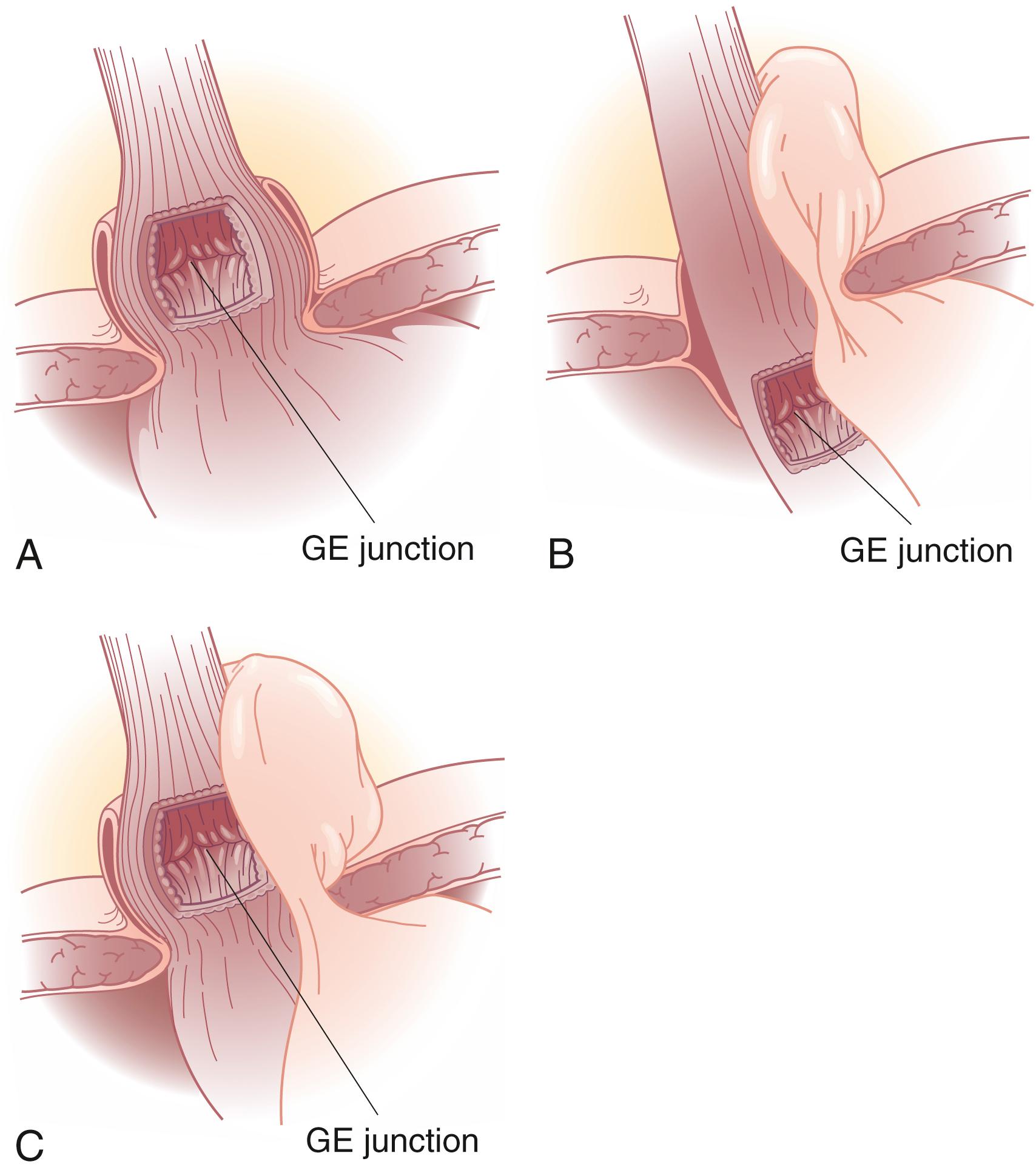
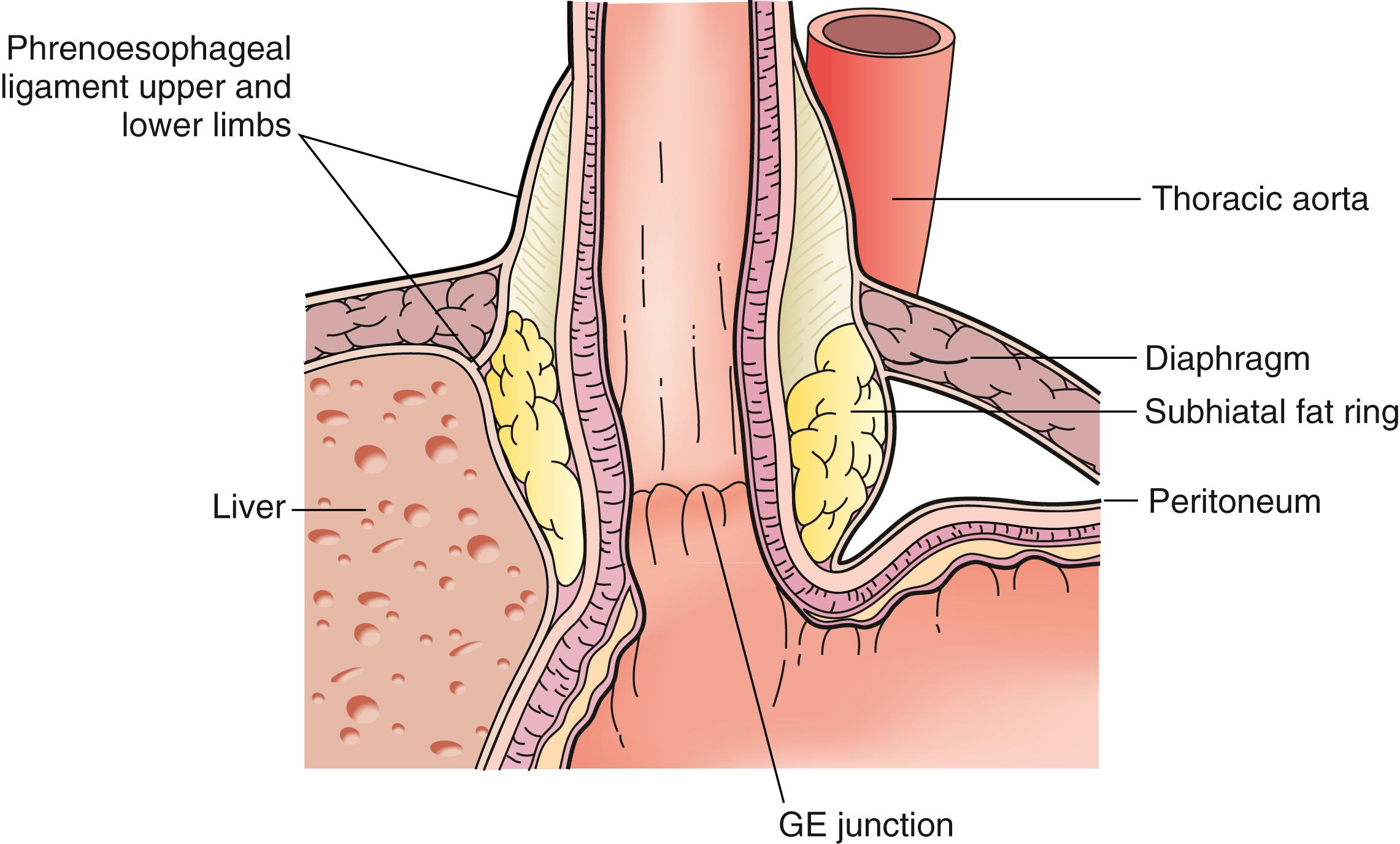
Hiatal hernia types II to IV, also referred to as PEH, are frequently associated with gastroesophageal obstructive symptoms (e.g., dysphagia, early satiety, and epigastric pain). However, they can also be associated with GERD. A type II hernia ( Fig. 43.2B ) occurs when the GEJ is anchored in the abdomen, and the gastric fundus migrates into the mediastinum through the hiatal defect. A type III hernia ( Fig. 43.2C ) is characterized by both the GEJ and fundus located in the mediastinum. Finally, a type IV hernia occurs when the stomach and any other visceral structure (e.g., colon, spleen, pancreas, or small bowel) migrates cephalad to the esophageal hiatus and into the mediastinum. For more information on PEH, refer to the last section of this chapter.
The prevalence of symptoms among 1000 patients with GERD is presented in Table 43.1 . Heartburn, regurgitation, and water brash are the three typical esophageal symptoms of GERD. Heartburn and regurgitation are the most common presenting symptoms. Heartburn is specific to GERD and described as an epigastric or retrosternal caustic or stinging sensation. Typically, it does not radiate to the back and is not described as a pressure sensation, which are more characteristic of pancreatitis and acute coronary syndrome, respectively. It is important to ask the patient about his or her symptoms in detail to differentiate typical heartburn from symptoms of peptic ulcer disease, cholelithiasis, or coronary artery disease.
| Symptom | Prevalence (%) |
|---|---|
| Heartburn | 80 |
| Regurgitation | 54 |
| Abdominal pain | 29 |
| Cough | 27 |
| Dysphagia for solids | 23 |
| Hoarseness | 21 |
| Belching | 15 |
| Bloating | 15 |
| Aspiration | 14 |
| Wheezing | 7 |
| Globus | 4 |
The presence of regurgitation often indicates progression of GERD. In severe cases, patients will be unable to bend over or lie supine without experiencing an episode of regurgitation. Regurgitation of gastric contents to the oropharynx and mouth can produce a sour taste that patients will describe as either acid or bile. This phenomenon is referred to as water brash. In patients who report regurgitation as a frequent symptom, it is important to distinguish between regurgitation of undigested food and regurgitation of digested food. Regurgitation of undigested food is not common in GERD and suggests the presence of a different pathologic process, such as an esophageal diverticulum or achalasia.
Extraesophageal symptoms of GERD arise from the respiratory tract and include both laryngeal and pulmonary symptoms ( Box 43.1 ). Two mechanisms may lead to extraesophageal symptoms of GERD. First, proximal esophageal reflux and microaspiration of gastroduodenal contents cause direct caustic injury to the larynx and lower respiratory tract; this is the most common mechanism. Second, distal esophageal acid exposure triggers a vagal nerve reflex that results in bronchospasm and cough. The latter mechanism is due to the common vagal innervation of the trachea and esophagus.
Hoarseness or dysphonia
Throat clearing
Throat pain
Globus
Choking
Postnasal drip
Laryngeal and tracheal stenosis
Laryngospasm
Contact ulcers
Cough
Shortness of breath
Wheezing
Pulmonary disease (asthma, idiopathic pulmonary fibrosis, chronic bronchitis, and others)
Unlike typical GERD symptoms (i.e., heartburn and regurgitation), extraesophageal symptoms of reflux are not specific to GERD. Before LARS is considered for a patient with primarily extraesophageal symptoms, it is necessary to determine whether those symptoms are due to abnormal GER or a primary laryngeal, bronchial, or pulmonary cause. This can be challenging. A lack of response of extraesophageal symptoms to proton pump inhibitor (PPI) therapy cannot reliably refute GERD as the cause of these symptoms. Although PPI therapy can improve or completely resolve typical GERD symptoms, patients with extraesophageal symptoms experience variable response to medical treatment. This may be explained by recent evidence suggesting that acid is not the only underlying caustic agent resulting in laryngeal and pulmonary injury. PPI therapy will suppress gastric acid production, but microaspiration of nonacid refluxate, which contains caustic bile salts and pepsin, can cause ongoing injury and symptoms. Therefore, in patients with extraesophageal symptoms of GERD, a mechanical barrier to reflux (i.e., esophagogastric fundoplication) may be necessary to prevent ongoing laryngeal, tracheal, or bronchial injury.
In patients who present with abnormal GER and bothersome extraesophageal symptoms, a thorough evaluation must be completed to rule out a primary disorder of the upper or lower respiratory tract. This should be completed whether or not typical GERD symptoms are also present. At the University of Washington Center for Esophageal and Gastric Surgery, we frequently refer patients with GERD and extraesophageal symptoms to a laryngologist or a pulmonologist to determine if a nongastrointestinal condition is causing these symptoms. If a nonreflux cause of the extraesophageal symptoms cannot be identified, then proceeding with an antireflux operation is acceptable. We counsel these patients a 70% likelihood of improvement in extraesophageal symptoms after LARS. If a patient’s laryngeal or pulmonary symptoms are not due to abnormal GER, an antireflux operation is not performed.
Increasing evidence suggests that GERD is a contributing factor to the pathophysiologic mechanism of several pulmonary diseases. In their extensive review, Bowrey and colleagues examined medical and surgical antireflux therapy in patients with GERD and asthma. In these patients, the use of antisecretory medications is associated with improved respiratory symptoms in only 25% to 50% of patients with GERD-induced asthma. Furthermore, less than 15% of these patients experience objective improvement in pulmonary function. One explanation for these results is that most of these studies lasted 3 months or less, which is potentially too short to see any improvement in pulmonary function. In addition, in several trials, gastric acid secretion was incompletely blocked by acid suppression therapy, and patients experienced ongoing GERD.
In patients with asthma and GERD, antireflux surgery appears to be more effective than medical therapy at managing pulmonary symptoms. Antireflux surgery is associated with improvement in respiratory symptoms in nearly 90% of children and 70% of adults with asthma and GERD. Several randomized trials have compared histamine 2 receptor antagonists and antireflux surgery in the management of GERD-associated asthma. Compared with patients treated with antisecretory medications, patients treated with antireflux surgery were more likely to experience relief of asthma symptoms, to discontinue systemic steroid therapy, and to improve peak expiratory flow rate.
Idiopathic pulmonary fibrosis (IPF) is a severe, chronic, and progressive lung disease that generally results in death within 5 years of diagnosis. Proximal esophageal reflux with microaspiration of acid and nonacid gastric contents has been implicated as one possible cause of alveolar epithelial injury that can lead to IPF. The incidence of GERD in patients with IPF has been reported to be as high as 94%. Because typical symptoms of GERD are not sensitive for abnormal reflux in patients with IPF, the threshold for testing patients with IPF for GERD should be low.
Medical treatment of GERD in patients with IPF is associated with longer survival and slower pulmonary decline. Whereas this is promising, PPI therapy does not prevent reflux of nonacid gastroduodenal contents, which may contribute to ongoing pulmonary injury in some patients. Therefore, in IPF patients with significant GERD, the argument can be made that a mechanical barrier to both acid and nonacid reflux (i.e., LARS) is more appropriate than PPI therapy. Although very little literature exists on LARS in patients with IPF, it appears to be safe and to provide effective control of distal esophageal acid exposure, and it may mitigate decline in pulmonary function.
Laparoscopic antireflux surgery for the treatment of idiopathic pulmonary fibrosis (WRAP-IPF) is a multicenter controlled phase 2 trial and the only randomized study comparing LARS to PPI therapy in patients with IPF and GERD confirmed by 24-hour pH probe. Of 72 eligible patients, 58 were equally randomized into surgery and no surgery groups (29 each group). The primary endpoint was change in forced vital capacity (FVC) at 48 weeks of treatment. Even in this patient population with severe systemic disease, LARS was deemed generally safe and well tolerated. Intention-to-treat analysis failed to show a difference between the two groups for FVC at 48 weeks ( P = 0.28), which was the primary endpoint. However, a more nuanced analysis of the data is necessary. The surgery group had one death and the no surgery group had four deaths, and all deaths were preceded by acute IPF exacerbation. The specified statistical analytic method assumes that any missing data (those from patients who died during the trial) is random. However, given that these deaths appeared directly due to progression of the underlying pulmonary disease, this missing data did not appear random. Consequently, a post hoc analysis was performed using an approach to this data (Lachin’s worst-rank analysis) that assumes missing data are not random and may be informative to the outcome of the study. Performing the analysis with this approach revealed a significant difference in FVC decline ( P = 0.017) that favored the LARS group. Furthermore, the surgery group showed less pulmonary disease progression as measured by 10% FVC decline, acute exacerbation, or death ( P = 0.048). Taken together, these results suggest that LARS may still play an important role in the mitigation of pulmonary decline in IPF patients with GERD. The failure to show a statistically significant difference in the intention to treat analysis may have resulted from an underpowered study, inappropriate choice of statistical analytic tool, or placing too much emphasis on decline of FVC. Future efforts to elucidate the role of LARS in IPF should take these considerations into account during study design and analysis.
Except in patients with severely advanced disease, the physical examination rarely contributes to confirmation of the diagnosis of GERD. In such patients, several observations may suggest the presence of GERD. For example, a patient who constantly drinks water during the interview may be facilitating esophageal clearance, which can suggest frequent reflux. Other patients with advanced disease will sit leaning forward and carry out the interview with their lungs inflated to almost vital capacity. This maneuver flattens the diaphragm, narrows the anteroposterior diameter of the hiatus, and increases the LES pressure to counteract GER. Patients who have severe proximal esophageal reflux and regurgitation of gastric contents into the mouth may develop erosion of their dentition (revealing yellow teeth caused by the loss of dentin), injected oropharyngeal mucosa, or signs of chronic sinusitis.
Although physical examination findings are generally not specific for GERD, the physical examination may be helpful in determining the presence of other disease processes. For example, supraclavicular lymphadenopathy in a patient with heartburn and dysphagia may suggest esophageal or gastric cancer. Similarly, if the patient’s retrosternal pain is reproducible with palpation, a musculoskeletal source of the pain should be investigated. Short of these extreme presentations, the physical examination is generally not helpful in confirming or excluding GER as a pathologic entity.
Frequently, the diagnosis of GERD is based on the presence of typical symptoms and improvement in those symptoms with PPI therapy. However, when a surgeon evaluates a patient for antireflux surgery, four diagnostic tests are useful to establish the diagnosis of GERD and to identify abnormalities in gastroesophageal anatomy and function that may have an impact on the performance of LARS.
Ambulatory pH monitoring quantifies distal esophageal acid exposure and is the “gold standard” test to diagnose GERD. A 24-hour pH monitoring is conducted with a thin catheter that is passed into the esophagus through the patient’s nares. The simplest catheter is a dual-probe pH catheter, which contains two solid-state electrodes that are spaced 10 cm apart and detect fluctuations in pH between 2 and 7. To ensure valid study results, the distal electrode must be placed 5 cm proximal to the LES; the location of the LES is identified on esophageal manometry (see next section). Alternatively, 48-hour ambulatory pH monitoring can be performed using an endoscopically placed wireless pH monitor.
Ambulatory pH monitoring generates a large amount of data concerning esophageal acid exposure, including total number of reflux episodes (pH <4), longest episode of reflux, number of episodes lasting longer than 5 minutes, and percentage of time spent in reflux in the upright and supine positions. A formula assigns each of these data points a relative weight according to its capacity to cause esophageal injury, and the composite DeMeester score is calculated. Abnormal distal esophageal acid exposure is defined by a DeMeester score of 14.7 or higher.
In addition to these objective data, the patient can keep track of reflux-related symptoms by pressing a button on an electronic data recorder. During the interpretation of the pH study, symptom index and symptom-associated probability are calculated on the basis of the temporal relationship between the symptom event and episodes of distal esophageal acid exposure ( Fig. 43.4 ). A symptom episode that occurs within 2 minutes of a reflux episode is defined as a close temporal relationship and suggests, but does not confirm, a cause and effect relationship between GER and the patient’s symptoms. When interpreting these studies, it should be remembered that patients often do not maintain their normal activities and eating patterns when they have the catheter in place. Consequently, their symptoms may not be as prevalent during the study period. Whereas the decision to perform LARS should not hinge on symptom correlation, it can help predict symptom improvement after LARS.
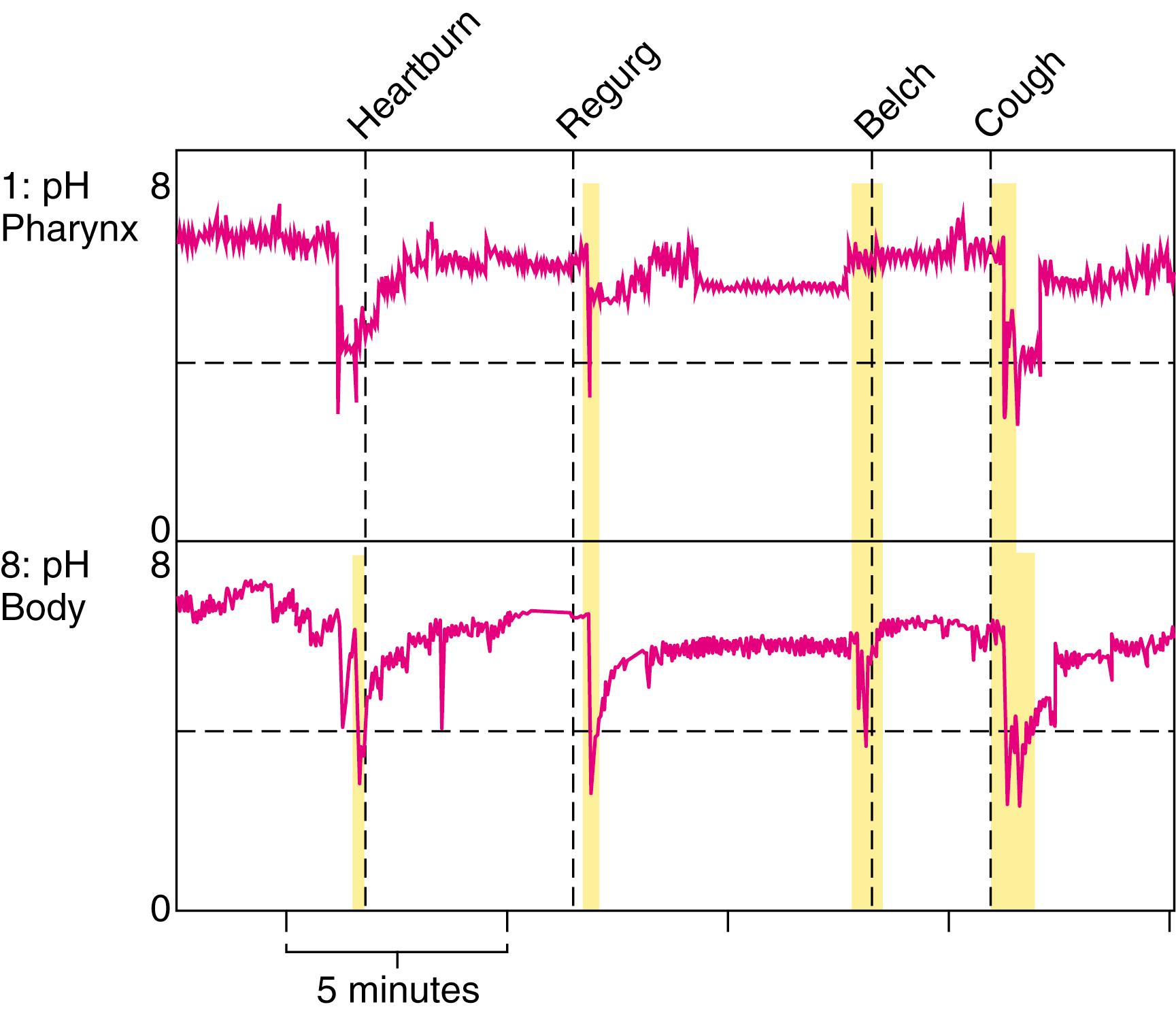
Esophageal impedance monitoring identifies episodes of nonacid reflux. Similar to 24-hour pH monitoring, esophageal impedance is performed with a thin, flexible catheter placed through the patient’s nares into the esophagus. Impedance catheters use electrodes placed at 1-cm intervals to detect changes in the resistance to flow of an electrical current (i.e., impedance). Impedance increases in the presence of air and decreases in the presence of a liquid bolus. Therefore, this technology can detect both gas and liquid movement in the esophagus.
Some impedance catheters also have one or more pH sensors, allowing the simultaneous detection of acid and nonacid reflux. When pH-impedance catheters are used, it is possible to determine the direction of movement of esophageal acid exposures and therefore to differentiate between an antegrade event (as in a swallow) and a retrograde event (as in GER). There also exists a specialized pH-impedance catheter with a very proximal pH sensor that detects pharyngeal acid reflux. This catheter can be useful in the evaluation of patients with extraesophageal symptoms, such as cough, throat clearing, hoarseness, and wheezing. One disadvantage of impedance technology, however, is that the automated analytic software is very sensitive and tends to overestimate the number of nonacid reflux episodes, mandating that these studies be manually reviewed and edited, which can be time-consuming.
Combined impedance-pH monitoring has been shown to identify reflux episodes with greater sensitivity than pH testing alone. Although there is no consensus on whether impedance-pH testing should be performed on or off acid-suppression therapy, our practice is to perform all pH and impedance-pH testing off acid suppression. Furthermore, how impedance-pH monitoring should guide the management of GERD is unknown. Patel and colleagues attempted to determine the parameters on esophageal impedance-pH monitoring that predict response of GERD symptoms to both medical and surgical treatment. They showed that acid exposure time, and not the number of nonacid reflux events, best predicted symptom improvement with both medical and surgical therapy. Although the addition of impedance monitoring increased the sensitivity of the study, nonacid reflux measurements alone were unable to accurately predict symptom response to medical or surgical therapy for GERD.
Esophageal manometry is the most effective way to assess function of the esophageal body and the LES. Standard esophageal manometry provides linear tracings of pressure waves of the esophageal body and LES ( Fig. 43.5 ). High-resolution esophageal manometry gathers data using a 32-channel flexible catheter with pressure-sensing devices arranged at 1-cm intervals, placed into the esophagus through the nares; the study is conducted in approximately 15 minutes, during which time the patient performs 10 swallows. A color-contour plot is generated and shows the response of the upper esophageal sphincter and LES as well as of the esophageal body; time is on the x-axis, esophageal length is on the y-axis, and pressure is represented by a color scale ( Fig. 43.6 ). In patients undergoing evaluation for GERD, esophageal manometry can exclude achalasia and identify patients with ineffective esophageal body peristalsis. Repeated exposure of the esophagus to gastric reflux can lead to esophageal motility disorders; in one study, 25% of patients with mild esophagitis demonstrated esophageal dysmotility, whereas 48% of patients with severe esophagitis had impaired motility on manometry. In patients with significant esophageal dysmotility who are undergoing LARS, the surgeon should consider a partial fundoplication to decrease the likelihood of postoperative dysphagia. A full discussion of the implications of esophageal dysmotility on the type of fundoplication is presented in a later section of this chapter. Esophageal manometry also measures the LES resting pressure and assesses the LES for appropriate relaxation with deglutition. Because the LES is the major barrier to GER, a defective LES is common in patients with GERD.
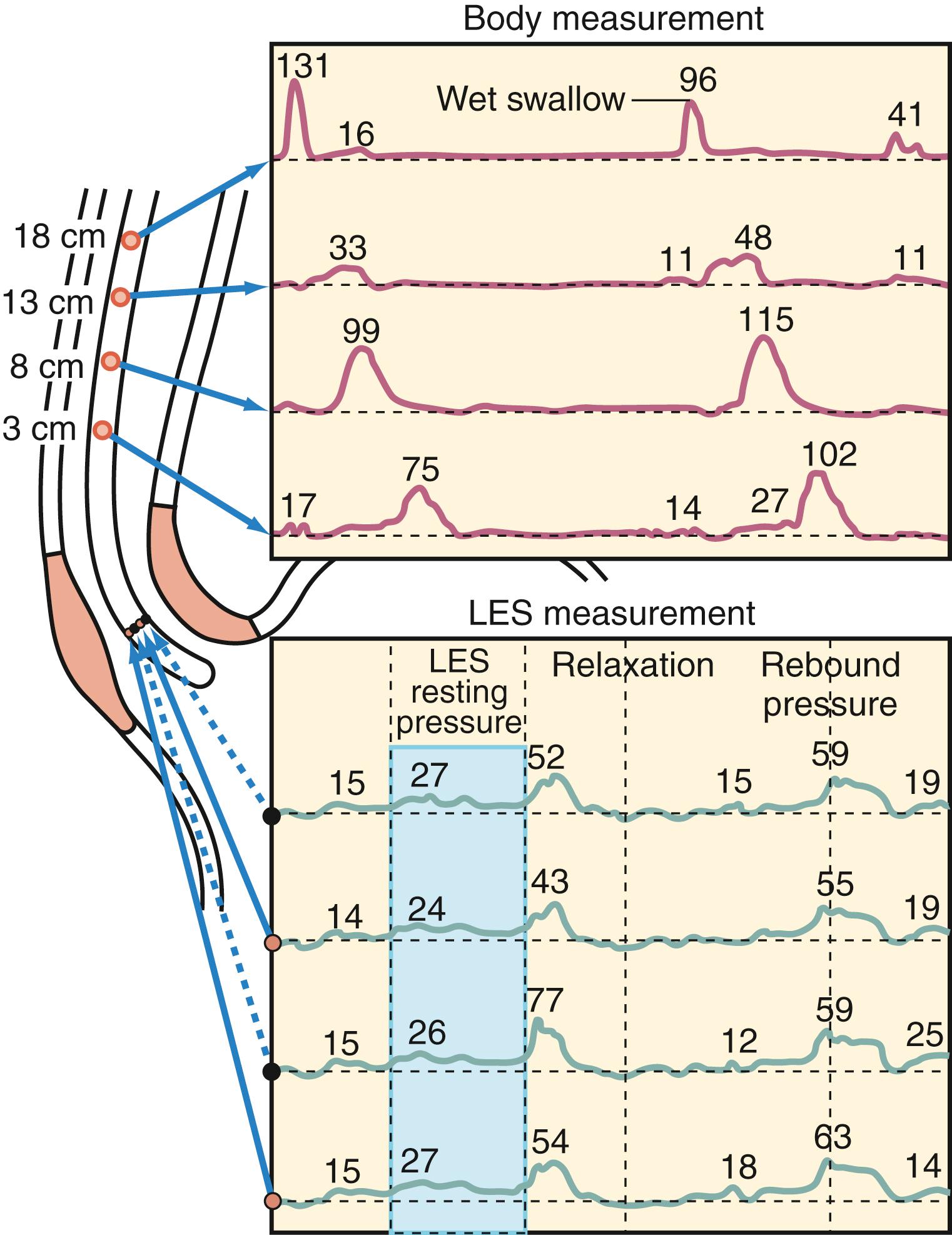
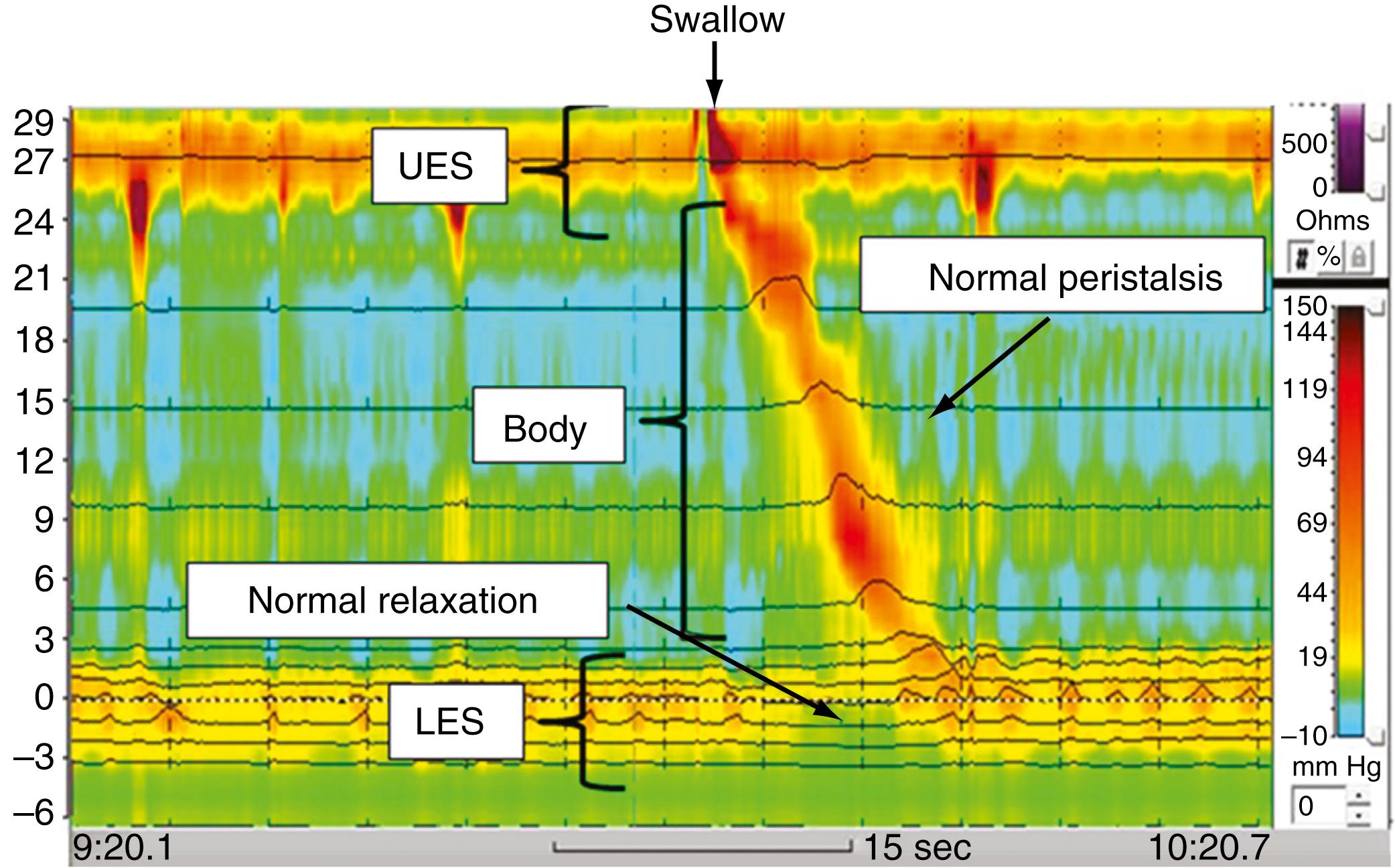
Endoscopy is an essential step in the evaluation of patients with GERD who are being considered for LARS. The esophagus should be examined for evidence of mucosal injury due to GER, including ulcerations, peptic strictures, and Barrett esophagus. Esophagitis can be reported according to several scoring systems, including the Savary-Miller and Los Angeles (LA) classifications. Both peptic strictures and LA class C and D esophagitis can be considered pathognomonic for GERD. Consequently, ambulatory pH monitoring is unnecessary in these patients. However, because of significant interobserver variability in LA class A and B esophagitis, these forms of mild esophagitis cannot be considered reliable markers of GERD. As such, patients found to have LA class A and B esophagitis should undergo pH testing to confirm abnormal distal esophageal acid exposure.
Endoscopic evaluation should also include an assessment of the GEJ flap valve. To do this, the endoscope is retroflexed 180 degrees in the stomach to visualize the GEJ from below. The flap valve is graded 1 to 4, according to the length of the valve and how tightly it adheres to the endoscope. The endoscopist should make note of the presence of a hiatal hernia, and the hernia should be measured in both cranial-caudal and lateral dimensions. In patients who are being evaluated for persistent or recurrent gastroesophageal symptoms after an antireflux operation or PEH repair, it is recommended that the surgeon who is evaluating the patient perform the endoscopy. This allows the operating surgeon to correlate endoscopic findings with the patient’s symptoms and data obtained on 24-hour pH monitoring, esophageal manometry, and upper gastrointestinal (UGI) series to determine if a functional or anatomic abnormality exists that can be corrected with reoperation.
Barium esophagram provides a detailed anatomic evaluation of the esophagus and stomach that is useful during preoperative evaluation of patients with GERD. Of particular importance are the presence, size, and anatomic characteristics of a hiatal hernia or PEH ( Fig. 43.7 ). For example, a GEJ that is fixed in the posterior mediastinum on esophagography can suggest a more difficult operation that may require a more extensive intrathoracic esophageal mobilization. Despite its ability to identify episodes of GER, which can occur spontaneously or in response to positioning of the patient during the study, barium esophagram cannot confirm or refute the diagnosis of GERD. On occasion, patients presenting to the surgical clinic for evaluation of GERD may have already undergone computed tomography scan of the chest or abdomen to evaluate atypical symptoms of GERD (e.g., chest or abdominal pain). Horizontal images as well as coronal and sagittal reconstructions can provide information concerning the anatomic relationship of the stomach and esophagus to other abdominal and thoracic structures. However, we still prefer to obtain a barium esophagram as computed tomography scan frequently fails to identify important anatomic and functional gastroesophageal disease.
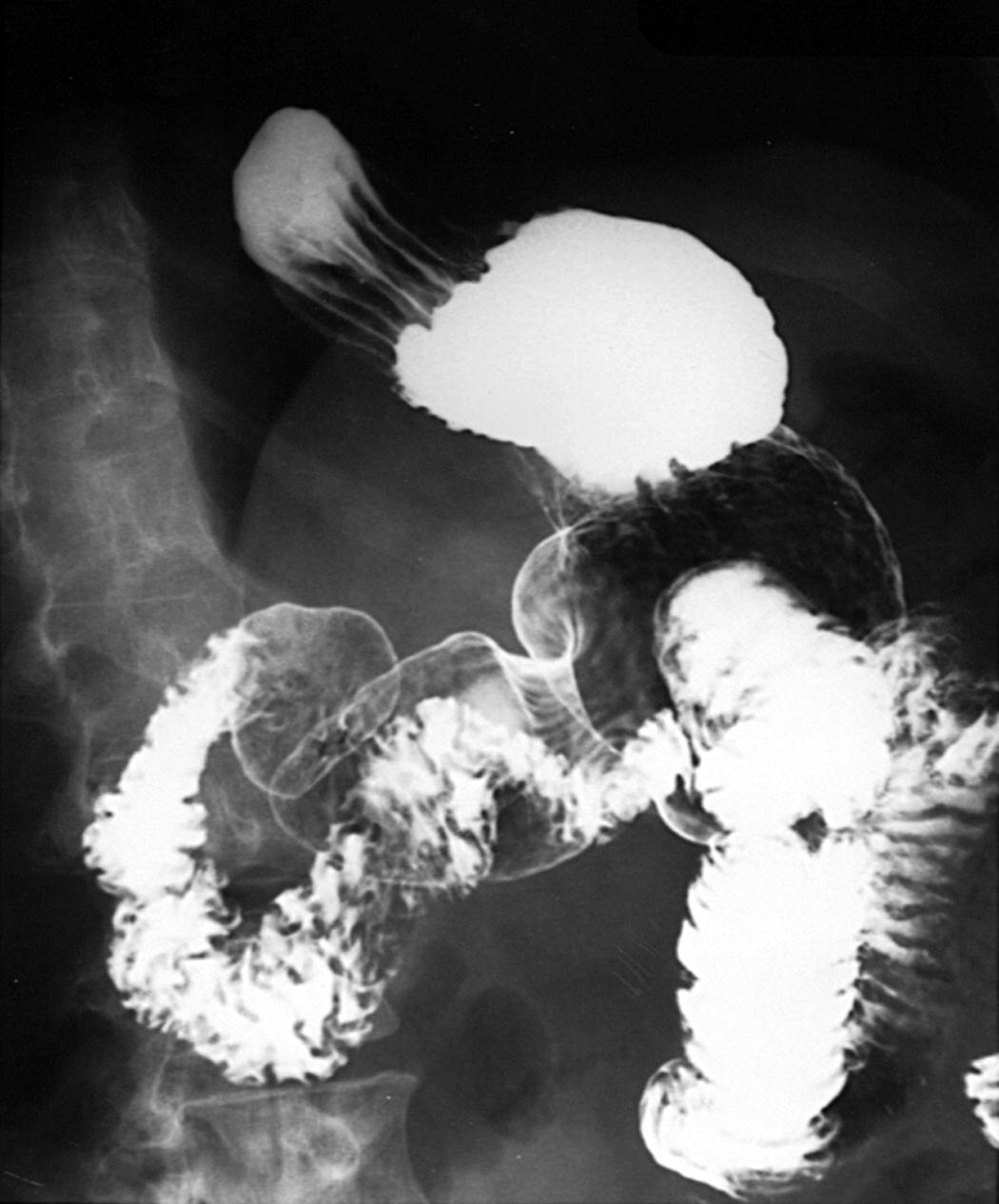
Additional gastroesophageal conditions that can be identified on barium esophagram are esophageal diverticula, tumors, peptic strictures, achalasia, dysmotility, and gastroparesis. If any one of these is found in a patient undergoing evaluation for GERD, LARS should be delayed until appropriate evaluation of the unexpected findings is completed.
Patients with GERD will occasionally experience dysphagia. The causes of dysphagia are listed in Box 43.2 . In patients with GERD, the most common cause of dysphagia is a reflux-associated inflammatory process of the esophageal wall. This inflammation can be manifested as a Schatzki ring, a diffuse distal esophageal inflammation, or a peptic stricture. Although relatively rare since the widespread adoption of PPI therapy, peptic strictures are pathognomonic for long-standing reflux and develop from the chronic mucosal inflammation that occurs with GERD. When strictures result in significant dysphagia, patients can experience weight loss and protein-calorie malnutrition. In addition, strictures can be associated with esophageal shortening, which makes obtaining adequate intra abdominal esophageal length at the time of operation more difficult (see “Intraoperative Management of Short Esophagus”).
Peptic strictures
Schatzki ring
Malignant neoplasm
Benign neoplasm
Foreign body
Become a Clinical Tree membership for Full access and enjoy Unlimited articles
If you are a member. Log in here